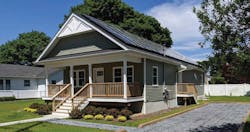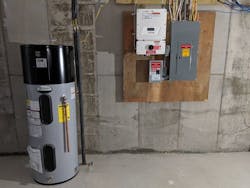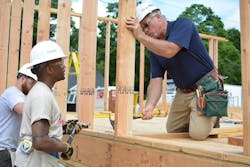United Way of Long Island, N.Y., is on a mission to reduce energy poverty among its community’s residents, one zero-energy ready home at a time. Along the way, the nonprofit is helping to fortify a workforce to build them. “We are committed to making net zero–energy homes available to people who need sustainable energy savings the most,” says Rick Wertheim, SVP for housing and green initiatives at United Way of Long Island.
In 2019, Brian Pullis, a retired Army Sergeant, moved with his family into a Department of Energy-certified Zero Energy Ready Home (ZERH) built by United Way. The three-bedroom home is equipped with an ultra-efficient electric heat pump for heating and cooling and features a 9.9 kW rooftop solar array, which most months offsets all of the family’s electricity use.
The purchase was especially meaningful because the home was built in part by veterans from VetsBuild, a construction training program hosted by United Way of Long Island that launched Pullis’ own career as an HVAC service technician following his military service.
A certified Zero Energy Ready Home meets the federal government’s most rigorous requirements for home performance, as well as those of the Environmental Protection Agency’s Indoor airPLUS and Energy Star programs. Since building its first certified ZERH home in 2013, United Way of Long Island has built more than 30 such homes and has been recognized with eight DOE Housing Innovation Awards.
More Zero-Energy Ready Homes for More Buyers
“This market has one of the highest costs of living in the country,” Wertheim says. Annual property taxes for a modest 1,200-square-foot home in a less-than-desirable neighborhood can approach $12,000. “On top of that, we have one of the highest utility rates in the country.”
Long Island is a largely suburban area, home to the wealthy section known as The Hamptons, but also to pockets of older residents living in homes that are in desperate need of energy upgrades, and renters making do in substandard and/or unpermitted units carved into garages and basements. Long Island also suffers from “brain drain,” as many young people are leaving in search of more affordable places to live.
RELATED
- Why Pay Attention to HVAC Faults? Energy Efficiency, for One Thing
- EPA Launches Series of Webinars on Energy Star Program and 45L Tax Credit
- UMass Students Create Affordable, Low-Carbon Home
The ZERH homes built by United Way of Long Island don’t just help address an urgent need for financially accessible housing, they also help demonstrate that net zero need not be exclusive to the elite, high-cost custom home market. “ZERH homes can come in all shapes, sizes, and price points,” says Sam Bowles, communications director for the ZERH program at the nonprofit. The value of a ZERH home, he says, is not in the use of expensive technologies and systems but in the construction details outlined in the program requirements, which, he says, “Are specifically designed to provide a comprehensive approach to building and ensure an efficient, durable, and healthy home.”
Showcasing Zero-Energy Ready Homes
Proving this point, several Habitat for Humanity Chapters have ZERH homes on the DOE’s Tour of Zero, an annual showcase of exemplary homes certified by the program. Many builders are using off-the-shelf products to achieve the required level of performance, Bowles adds. “Some production builders even have different product lines proving that the ZERH certification is not about the expense but about the way the homes are put together.”
Atlanta-based home builder Beazer Homes announced late last year that it is committing to building 100% ZERH by the end of 2025 (the builder closed 4,246 homes in 2023). To date, Beazer has built Zero Energy Ready Homes for homeowners across the spectrum, from communities of single-family homes that sell at a mid-to-high price point to townhomes that cost far less.
Some production builders even have different product lines proving the ZERH certification is not about the expense but about the way the homes are put together.
Affordability goes beyond initial cost. “Any homeowner knows that the true cost of homeownership is much more than a mortgage payment,” Bowles says. “It’s monthly utility bills; it’s maintenance and repair costs. By starting with a high-quality product like a ZERH-certified home, you can significantly reduce all of those expenses.”
The ZERH homes built by United Way of Long Island are so airtight and thermally efficient that they still achieve a net-zero energy balance even when equipped with electric vehicle charging stations, essentially removing the cost of transportation from family budgets as well.
For Pullis, the Long Island veteran, knowing his monthly utility bills would be consistently low gave him the confidence to move forward with the purchase of his new home. Most months, he just pays the utility tax charge, and his bills rarely exceed $100. In total, the family saves approximately $3,200 per year in utility costs, compared with a home built to energy-code minimum standards.
Programs that provide emergency financial assistance for fuel are important and necessary, but they’re a Band-Aid, according to Wertheim: “We recognize that the only sustainable solution is to change out our housing stock and build more and more net-zero and net-positive homes.”
Building a Zero-Energy Ready Home Workforce
Scaling up the production of ZERH homes will require a deep pool of skilled labor. “The new technologies, systems, and building practices that make our homes more efficient require workers who understand how the house works as a system and the building science behind it,” Bowles says.
And yet, the housing industry faces a dearth of skilled labor across all construction trades. With that, nearly a quarter of all construction workers are over the age of 55, and skilled career professionals are at or nearing retirement age.
“Most young people are not as interested in going into the trades,” Wertheim says. “It’s a systemic problem across the country, in everything from HVAC to iron workers.” Those that are entering the industry are drawn to the most lucrative trades, leaving shortfalls in others.
A program like VetsBuild is helping to address this urgent need and is one of three signature programs United Way of Long Island runs through its E3 SmartBuild Training Center, a 5,000-square-foot facility in Deer Park, Long Island, N.Y.
When Pullis left the Army in 2013, he wasn’t sure what to do with himself as a civilian worker and was missing the purpose he felt as an infantryman serving three tours in Afghanistan. Then he discovered VetsBuild, which serves returning veterans from Iraq and Afghanistan, and took advantage of all of the program’s offerings, including green home building, energy auditing, home performance, and information technology, among other training.
The VetsBuild training center is a partnership between United Way and the New York State Energy Research and Development Authority, the state’s utility, and was funded with $1 million from Congress; an additional $250,000 of funding from the State of New York enabled the construction of a “pressure house,” a state-of-the-art building-science laboratory where students can learn hands-on skills and obtain Building Performance Institute National Home Performance credentials to take into the market.
The focus on workforce development is not exclusive to the Long Island nonprofit, Bowles says. “The builders involved in the ZERH program are passionate leaders who believe that this is the right way to build homes, and they don’t want their life’s work to pass when they are retired.”
For example, YouthBuild serves low-income, out-of-school, unemployed young adults between the ages of 18 and 24, while a newer program, called Power Up Academy, emphasizes high-performance construction, energy retrofits, and renewable energy. Last year about 350 people took part in those programs, which range from weatherization and HVAC to renewable energy and building science principles. Some coursework is offered free of charge.
The focus on workforce development is not exclusive to the Long Island nonprofit, Bowles says. “The builders involved in the ZERH program are passionate leaders who believe that this is the right way to build homes, and they don’t want their life’s work to pass when they are retired.”
Tim O’Brien Homes, a high-performance home builder in Wisconsin, was recognized in DOE’s 2022 Housing Innovation Awards with a special award for Workforce Development. The builder partners with area high schools in Milwaukee and Madison to develop their trade programs, and students gain hands-on experience by building a home alongside experienced builders and tradespeople.
In 2023, Habitat for Humanity North Central Connecticut earned a special “Class is in Session” Award for their exceptional workforce development and educational outreach. The nonprofit used a 1,397-square-foot home project to educate builders, the public, the home’s owners, and the nonprofit’s staff and volunteers.
Volunteers were trained on all aspects of the high-performance home, from building walls using insulated concrete forms to air-sealing the vented attic. The homeowners, who were required to contribute 150 hours of sweat equity, learned how the components and systems in their new home work together to ensure the performance, comfort, and health benefits they now enjoy. The Habitat chapter also hosted tours of the home and presented the project at several industry conferences.
What's Next for Zero-Energy Ready Homes?
The next version of the ZERH program for single-family homes will highlight the need for skilled high-performance home contractors and tradespeople, while pushing builders to achieve ever higher standards.
The new version supports DOE’s goals of achieving low-to-no carbon emissions in all new home construction by 2035 with new requirements, including enhanced building envelope performance and several new provisions for electric-ready homes, such as dedicated circuits for electric vehicle charging stations and electric heat pumps.
“The ZERH program has always served as a proving ground to what home performance should be,” Bowles says. “Our partners are truly the boots on the ground fighting against climate change while also delivering more efficient, resilient, and healthier homes to American homebuyers.”
Juliet Grable writes about the built environment, energy, climate change, species conservation, and environmental restoration. She lives in southern Oregon.



